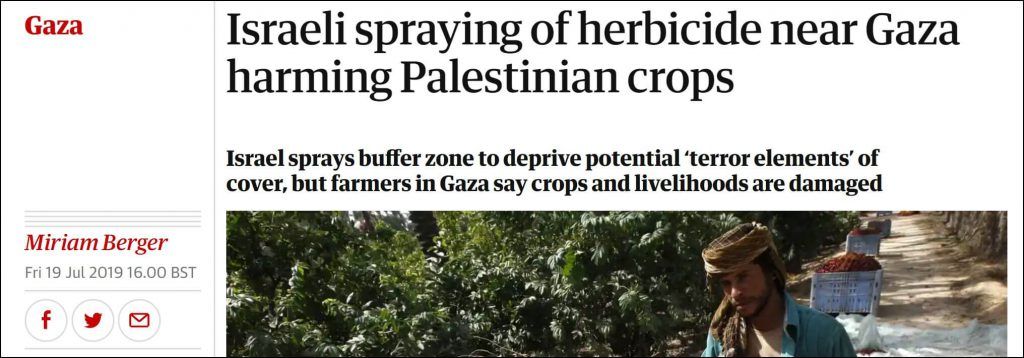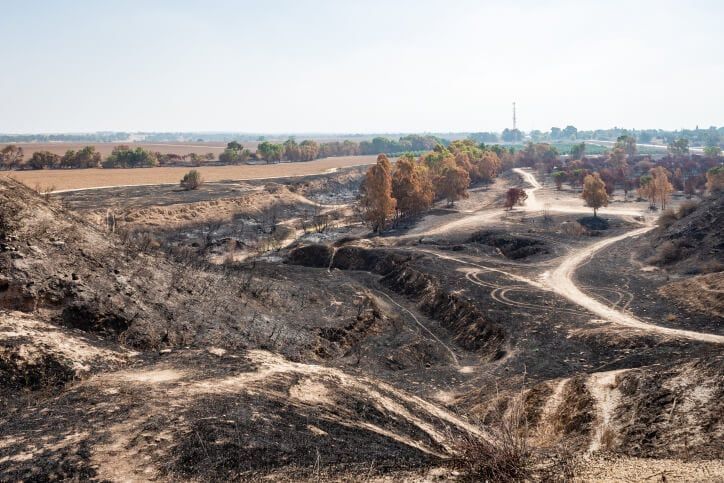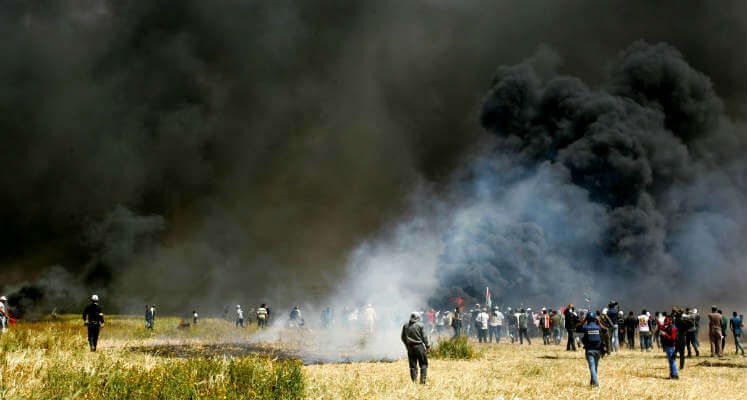Israel has been accused of many things when it comes to its treatment of Palestinians, including the false charge of genocide. Here’s a new one: Herbicide.

The Guardian reports:
Israeli aircraft spraying herbicide beside the buffer zone along the Gaza strip is directly affecting the livelihoods of Palestinians in violation of international standards, a new report claims.
The study tracked the drift of the herbicides on to the Gazan side and concluded it was killing agricultural crops and causing “unpredictable and uncontrollable damage”, according to the report’s main researcher.
Forensic Architecture, a research agency based at Goldsmith’s University, London has apparently spent 16 months investigating. This is the research agency behind the front-page revelation in the New York Times in December 2018 that a Palestinian medic was killed by mistake after a bullet fragment tragically ricocheted into her, but nevertheless managed to suggest that her killing was perhaps not accidental.
It’s also the research agency whose director prompted an astonishing story in the Financial Times attacking Israeli shrubs and trees for “erasing memory” of other peoples.
Join the fight for Israel’s fair coverage in the news
Forensic Architecture’s latest foraging for evidence to soil Israel’s image, courtesy of The Guardian, presents Palestinians as victims of some malevolent herbicide spraying that is taking place on the Israeli side of the border.
Why does Israel need to use herbicide at all?
As with so many Israeli actions, this is a response to Palestinian violence and the need to maintain Israeli security. The Gaza security fence can be breached by terrorists or other Palestinian infiltrators who are able to use the undergrowth to avoid detection. The IDF needs to be able to spot any infiltrators to prevent attacks on nearby Israeli communities.
Undergrowth can also be used to cover up the openings to attack tunnels running under the border from Gaza, many of which have been discovered in recent years.
And why is it necessary to use a plane to spray the area? It’s not hard to imagine, particularly in light of the violent Palestinian riots and violence during the March of Return, what would happen if Israeli soldiers or civilians carried out the spraying manually. No doubt they would be met with bullets, rocks or firebombs.
It’s difficult to treat The Guardian’s story with any sympathy given its failure to mention the real environmental destruction going on near the Gaza border. In the past year, hundreds of incendiary balloons and kites have been launched by Palestinians leading to the destruction of thousands of acres of forest and Israeli farmland, wiping out flora and fauna and decimating livelihoods.

And driven by the same wind that is allegedly spreading the herbicide further over the Gaza border. Why shouldn’t Israel prioritize the preservation of its own greenery above that of a relatively small area of Gaza?
Yet, according to The Guardian and Forensic Infrastructure, Israel is the real menace to the local environment. The same environment that has been damaged on the Gaza side of the border where tires have been burned and toxic smoke emitted, affecting Palestinians as well as Israelis.

Gaza, where it took enormous amounts of Israeli agricultural technology and ingenuity to grow crops in unfavorable conditions. Where state of the art greenhouses were left to the Palestinians when Israel disengaged from Gaza in 2005, yet were destroyed by the very people who could have benefited from them.
Gaza, where a lack of a properly functioning sewage system has polluted the water sources and the groundwater. Along with the aforementioned toxic pollutants, couldn’t there be any number of contributory factors affecting Palestinian agriculture other than Israeli herbicides?
With its embedded video from Forensic Architecture presenting crop dusting as a sinister activity, and the comments of highly politicized anti-Israel non-governmental organizations such as Adalah and Al-Mezan, it’s hardly a stretch before herbicides, used to control weeds and undergrowth, become likened to the equivalent of chemical weapons.
It’s not genocide, it’s herbicide.


